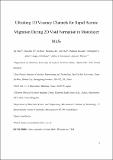| dc.contributor.author | Chen, Qu | |
| dc.contributor.author | Li, Huashan | |
| dc.contributor.author | Zhou, Si | |
| dc.contributor.author | Xu, Wenshuo | |
| dc.contributor.author | Chen, Jun | |
| dc.contributor.author | Sawada, Hidetaka | |
| dc.contributor.author | Allen, Christopher S. | |
| dc.contributor.author | Kirkland, Angus I. | |
| dc.contributor.author | Grossman, Jeffrey C. | |
| dc.contributor.author | Warner, Jamie H. | |
| dc.date.accessioned | 2022-05-31T20:10:44Z | |
| dc.date.available | 2021-10-27T20:29:23Z | |
| dc.date.available | 2022-05-31T20:10:44Z | |
| dc.date.issued | 2018-08 | |
| dc.date.submitted | 2018-03 | |
| dc.identifier.issn | 1936-0851 | |
| dc.identifier.issn | 1936-086X | |
| dc.identifier.uri | https://hdl.handle.net/1721.1/135804.2 | |
| dc.description.abstract | © 2018 American Chemical Society. High-energy irradiation of materials can lead to void formation due to the aggregation of vacancies, reducing the local stress in the system. Studying void formation and its interplay with vacancy clusters in bulk materials at the atomic level has been challenging due to the thick volume of 3D materials, which generally limits high-resolution transmission electron microscopy. The thin nature of 2D materials is ideal for studying fundamental material defects such as dislocations and crack tips and has potential to reveal void formation by vacancy aggregation in detail. Here, using atomic-resolution in situ transmission electron microscopy of 2D monolayer MoS2, we capture rapid thermal diffusion of S vacancies into ultralong (∼60 nm) 1D S vacancy channels that initiate void formation at high vacancy densities. Strong interactions are observed between the 1D channels and void growth, whereby Mo and S atoms are funneled back and forth between the void edge and the crystal surface to enable void enlargement. Preferential void growth up to 100 nm is shown to occur by rapid digestion of 1D S vacancy channels as they make contact. These results reveal the atomistic mechanisms behind void enlargement in 2D materials under intense high-energy irradiation at high temperatures and the existence of ultralong 1D vacancy channels. This knowledge may also help improve the understanding of void formation in other systems such as nuclear materials, where direct visualization is challenging due to 3D bulk volume. | en_US |
| dc.language.iso | en | |
| dc.publisher | American Chemical Society (ACS) | en_US |
| dc.relation.isversionof | http://dx.doi.org/10.1021/acsnano.8b01610 | en_US |
| dc.rights | Article is made available in accordance with the publisher's policy and may be subject to US copyright law. Please refer to the publisher's site for terms of use. | en_US |
| dc.source | other univ website | en_US |
| dc.title | Ultralong 1D Vacancy Channels for Rapid Atomic Migration during 2D Void Formation in Monolayer MoS 2 | en_US |
| dc.type | Article | en_US |
| dc.contributor.department | Massachusetts Institute of Technology. Department of Materials Science and Engineering | |
| dc.relation.journal | ACS Nano | en_US |
| dc.eprint.version | Author's final manuscript | en_US |
| dc.type.uri | http://purl.org/eprint/type/JournalArticle | en_US |
| eprint.status | http://purl.org/eprint/status/PeerReviewed | en_US |
| dc.date.updated | 2019-09-19T14:18:05Z | |
| dspace.orderedauthors | Chen, Q; Li, H; Zhou, S; Xu, W; Chen, J; Sawada, H; Allen, CS; Kirkland, AI; Grossman, JC; Warner, JH | en_US |
| dspace.date.submission | 2019-09-19T14:18:07Z | |
| mit.journal.volume | 12 | en_US |
| mit.journal.issue | 8 | en_US |
| mit.metadata.status | Authority Work Needed | en_US |
